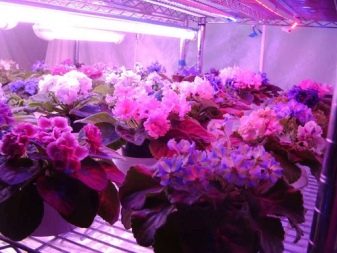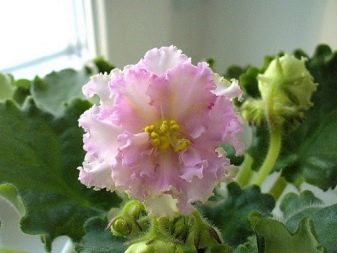Features of the violet "Gold of the Scythians"

Many people decorate their homes with various indoor flowers. Often, housewives grow Saintpaulia, although more often it is called a violet. The article discusses a variety with an interesting name "Scythian Gold".

Description of the variety
Saintpaulia of this variety is distinguished by large double flowers of white and yellow colors. Her petals are corrugated, with a pale pink border. In cooler weather, a slight green fringe may form on the edges. In a flower that has not bloomed to the end, the petals have a light monochromatic color. A brighter color appears during the growth and development of the plant. This happens within 2-4 days.
Violet leaf blades are slightly wavy. They have an elongated shape with raised edges. The color is medium green. Each peduncle has 3-4 buds. They are generally sturdy and will not fall apart.


Currently, there are varieties of LE-Gold of the Scythians and AV-Gold of the Scythians.... They are almost the same, although the first option is most often a brighter pink tint.
Such violets need to be transplanted only once a year. It is recommended to carry out treatment against the appearance of harmful insects and diseases twice a year.
To form a beautiful flower, you do not need to remove the petals from the central part of the rosette. Violets create the rosette and buds themselves.
If the peduncles cannot rise above the foliage and form lush flowers, this means that the plant is sick. In this case, it is better to treat Saintpaulia with chemicals.


Care
Violets "Gold of the Scythians" are fragile and delicate, they need a lot of light. Therefore, such plants can only be placed in rooms with good lighting. Otherwise, the flowers will not be able to grow and develop normally. It should be borne in mind that the best option for violets is soft diffused light... Direct rays of the sun can only harm the flowers.
Due to lack of light, violets can become dull and lethargic. Strong pulling of the cuttings can also occur. Do not forget that in winter you need to organize additional artificial lighting.so that indoor plants can stay in shape.
Attention should be paid to the choice of a suitable land for planting violets. It can be purchased at almost any flower shop.
Often, the soil is prepared independently at home. To make it, you need to carefully sift the garden soil and mix it with a little sand. After that, the resulting mass is well calcined in the oven. This is done in order to cleanse the mixture of all parasites and pathogens.


A special drainage filler should be placed at the bottom of the container in which the plant will be planted. As a rule, it is made from expanded clay. It will avoid the accumulation of a large amount of moisture in the root system of violets.
When choosing the right pot, you should consider the size. The containers for flowers are divided into several groups depending on this parameter:
- subminiature (diameter 5-7 centimeters);
- miniature (diameter 18-20 centimeters);
- large (diameter more than 40 centimeters).
For plants of this variety, too small a container is not suitable, because this will not allow the root system to develop normally. Such options can only be used for very young violets. Adult plants are recommended to be planted in miniature pots (from the second group).
Too large containers should also not be used for such indoor flowers, as this can cause the root system to grow strongly, and flowering will not come soon.


We must not forget about watering. Its frequency depends on the season (when the heat comes, it can be done a little more often). The violet should be watered at least once a week as the soil dries out. You cannot moisten a flower with a spray bottle.
Violets love high levels of humidity, so often flower growers place a separate container filled with clean water near the plant pot. You can also use a damp sponge or cloth.
Some people use special devices that increase the humidity in the room.


Top dressing is an important point. They need to be introduced only during the period of intensive growth and development. In winter and autumn, it is better not to fertilize the plants. For the flowering of violets, it is necessary to use phosphorus and potassium. For foliage growth, nitrogen-containing formulations should be used.
Often, due to improper care, violets can hurt. So, at low humidity in the room, leaf blades can turn yellow. If the temperature is too low, rot may appear in the root system of the plant or fusarium may develop.... In such cases, all affected leaf plates are first cut off. Only after that, you can start treating violets with the help of special chemicals.

Reproduction
The most common propagation option for these indoor flowers is cuttings. In this case, the cuttings can be immediately planted in pre-prepared soil and grown there. Remember that young leaves should be handled as carefully as possible. They are too fragile and easily damaged and broken. Better to take them from a plant that is in bloom or is about to bloom. Planting cuttings in the ground is carried out at a certain angle (45 degrees).
For reproduction, it is better to choose a leaf from the central part of the outlet. He should not be too young, but at the same time completely healthy. It is recommended to process a sheet cut with a solution of potassium permanganate or powdered coal. After that, the planting material should be placed in a container with warm clean water. Such a procedure is carried out for rooting.
After 17-20 days, roots begin to appear on the leaf. After that, it can already be planted in the ground. It is desirable that it contains sand, some peat and perlite. After planting, the cutting is covered with a small cap. It must be transparent, because young plants at the initial stages of development should be in conditions resembling greenhouse ones.


You will learn how to transplant a violet correctly from the video below.































The comment was sent successfully.